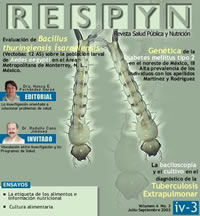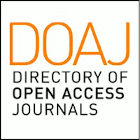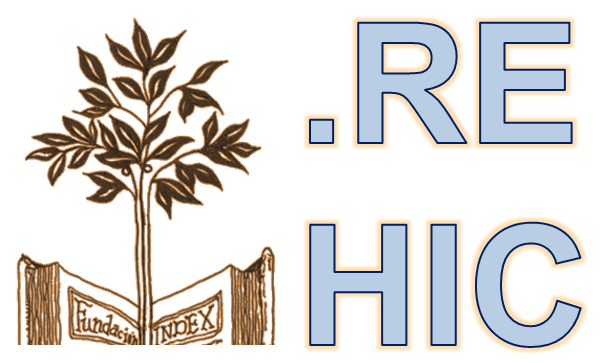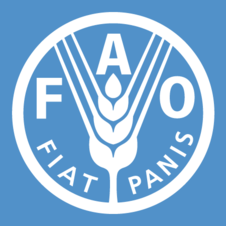EVALUACIÓN DE Bacillus thuringiensis isaraelensis ( VECTOBAC 12 ASâ ) SOBRE LA POBLACIÓN LARVAL DE Aedes aegypti EN EL ÁREA METROPOLITANA DE MONTERREY N. L. MEXICO
Abstract
Cada día la infraestructura y recursos humanos en el país son rebasados por la
demanda de la población esto debido a que el crecimiento poblacional tiene un
marcado incremento y por otro lado, la eficiente labor del servidor de la salud ha
logrado aumentar la esperanza de vida al nacer, todo esto no es proporcional a los
recursos disponibles para su atención, por ello es necesario buscar nuevas estrategias
mediante las cuales, las acciones encaminadas a preservar la salud lleguen a la
población optimizando recursos. En Nuevo León el dengue es una prioridad en Salud
Pública por lo cual se buscan nuevas alternativas para su control; la estrategia que se
ha utilizado en la entidad a través de los Servicios de Salud es la aplicación de
larvicidas mediante la visita domiciliaria o la distribución de este producto en unidades
de salud o centros de afluencia poblacional (mercados, centros comerciales, escuelas,
etc.), obviamente esta estrategia requiere de una gran movilización de personal, en
cambio la Utilización de camiones pipas tratados con Bti reduce el empleo de recursos
humanos no siendo así la cobertura de viviendas tratadas. En el presente estudio se
probo el bioinsecticida Vectobac 12 AS, formulado a base de Bacillus thuringiensis var
israelensis el cual fue aplicado en camiones pipa que distribuyen agua a diversas
comunidades del área metropolitana, de tal manera, que una vez que la comunidad
recibe dicho recurso, este ya contiene un producto que interrumpirá el ciclo biológico
del Aedes aegypti (L) vector del virus del dengue.
Palabras clave: Bacillus thuringiensis var israelensis, Aedes aegypti, bioinsecticida Bacillus thuringiesis var israelensis, Aedes aegypti, bioinsecticide
Downloads
References
Falcon, L. A. 1971. Use of bacteria for microbial control. In: microbial control of
insects and mites. Burges, H.D. y N. W. Hussey (eds.) Academics Press, N.Y.
Novak, R. J., D. J. Gluber and D. Underwood. 1985. Evaluation of slow – release
formulations of themephos (abate) and Bacillus thuringiensis var israelensis for the
control of Aedes aegypti (L) in Puerto Rico. J. Am. Mosq. Control Assoc. 1 (4): 449-453
pp.
Culebro C., M. De J. 1989. Evaluación en laboratorio y campo de una formulación a
base seBacillus thuringiensis var. Israelensis H-14 en larvas de Aedes aegypti (L)
y Culex sp. (diptera: culicidae). Tesis inédiata. F.C.B., U.A.N.L. Monterrey, N.L. México.
-55 pp.
Rodríguez. Tovar, Ma. L. 1994. Diseño y evaluación de formulados de Bacillus
thuringiensis var. israelensis en laboratorio y campo de Culex pipiens
quinquefasciatus (Say) y Aedes aegypti (L). Tesis inédita. F.C.B. U.A.N.L. Monterrey,
N.L. México 51-107 pp.
Varjal de Melo-Santos M. A., E. Gomez Sanchez E., F. Justino y L. Regis. 2001.
Evaluation of a new tablet formulation based on Bacillus thuringiensis var.
Israelensis for larvicidal control ofAedes aegypti (L). Mem. Inst. Oswaldo Cruz, Rio de
Janeiro. Vol 96.
Fernández I. 1999. Biología y control de Aedes aegypti (L), Manual de operaciones.
Universidad Autónoma de Nuevo León. 1-80pp.
Ponce, G., AE Flores, MH Badii, ML Rodriguez and IF Salas 2002. Laboratory
evaluation of Vectobac® AS against Aedes aegypti (L) in Monterrey, Nuevo León,
México. J. Am. Mosq. Control Assoc. 18(4):341-343.
WHO (World Health Organization). 1981. Instructions for determining the
susceptibility or resistance of mosquito larvae to insecticida WHO/VBC/81.807.
Geneva, Switzerland: World Health Organization.
Fernandez, I. Op.Cit.
Becker N., M. Zgomba, M. Ludwing, D. Petric and F. Rettich. 1992. Factors
influencing the activity of Bacillus thuringiensis var israeliensis treatments. Jour. of the
American Mosquito Control Association. 8(3)285-289.
Novak, R. et. al. Op.Cit.
Rodríguez. Tovar, Ma. L., Op.Cit.
Sulaiman, S., Z. A. Pawanche, A. Wahab, J. Jamel and A. R. Sohadi, 1997. Field
evaluations of Vectobac G, Vectobac 12 AS and Bactimos WP against the dengue
vector Aedes albopictus tires. Journal of Vector Ecology. 22 (2): 122-124 pp.
Wilmot T.R., D.W Allen and B.A. Hankarson. 1993. Fiel trial of two Bacillus
thuringiensis var israeliensis formulations for control of Aedes species mosquitoes in
Micahigan Woodlands. Jour. of the American Mosquito Control Association. 9(3)344-
Knepper R.G., S.A. Wagner, E. Abiel and E.D. Walker. 1994. Fixed-wing, aerial
aplication of liquid Bacillus thuringiensis H-14 (Acrobeâ ) for control of spring Aedes
mosquitoes in Michigan.
Downloads
Published
How to Cite
Issue
Section
License
Copyright (c) 2003 Gustavo Ponce, Adriana. E. Flores, Mohammed H. Badii, Ildefonso Ildefonso Fernández, Teresa González, María L. Rodríguez, Jesús. A. Chiu

This work is licensed under a Creative Commons Attribution 4.0 International License.
The rights of the work belong to the author or authors, however, by sending it for publication in the Public Health and Nutrition Magazine of the Faculty of Public Health and Nutrition of the Autonomous University of Nuevo León, they grant the right for its first publication in between electronic, and possibly, in print to the Public Health and Nutrition Magazine. The license used is the Creative Commons attribution, which allows third parties to use what is published whenever the authorship of the work is mentioned and the first publication that is in the Public Health and Nutrition Magazine. Likewise, the author or authors will take into account that it will not be allowed to send the publication to any other journal, regardless of the format. The authors will be able to make other independent and additional contractual agreements for the non-exclusive distribution of the version of the article published in the Public Health and Nutrition Magazine (e.g., institutional repository or publication in a book) provided they clearly state that The work was published for the first time in the Public Health Magazine, Magazine of the Faculty of Public Health and Nutrition of the Autonomous University of Nuevo León.










